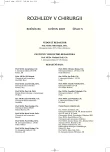Radiofrequency-assisted Liver Resection. Analysis of a Group of Consecutive Patients Treated at a Single Centre
Authors:
A. Ferko 1,2; Z. Šubrt 2; E. Havel 1; B. Melichar 3,4; B. Jon 1
Authors‘ workplace:
Klinika chirurgie Lékařské fakulty Univerzity Karlovy a Fakultní nemocnice v Hradci Králové
přednosta kliniky: doc. MUDr. A. Ferko, CSc.
1; Katedra válečné chirurgie, Fakulta vojenského zdravotnictví, Univerzita Obrany Brno, vedoucí katedry:
doc. MUDr. A. Ferko, CSc.
2; Klinika onkologie a radioterapie Lékařské fakulty Univerzity Karlovy a Fakultní nemocnice
v Hradci Králové, přednosta kliniky: doc. MUDr. J. Petera, CSc.
3; Katedra vnitřních oborů Lékařské fakulty Univerzity Karlovy a Fakultní nemocnice v Hradci Králové
vedoucí katedry: prof. MUDr. J. Malý, CSc.
4
Published in:
Rozhl. Chir., 2007, roč. 86, č. 5, s. 228-232.
Category:
Monothematic special - Original
Overview
Aim:
To evaluate clinical experience with radiofrequency (RF)–assisted liver resection in patients with metastatic liver disease.
Methods:
A group of consecutive patients who underwent liver resection using the RF-assisted technique were prospectively followed.
Results:
Between July 2005 and September 2006, 65 liver resections were performed, among these, 40 procedures were performed using the RF technique for metastatic disease. The mean operative time was 141 (range 64–233) minutes, and the mean duration of RF parenchyma coagulation of the resected surface was 17.5 (range 2–32.5) minutes; mean 10 (range 9–12) minutes in the case of right hemihepatectomy. Blood transfusions associated with the operation were administered in 3 (7.5%) patients. The mean number of transfusion units of red blood cells administered was 0.2 (range 0–3). Liver resection was complicated by biliary fistula in 1 patient (2.5%) after mesohepatectomy, hepatic abscess was observed in 1 patient (2.5%) and subdiaphragmatic abscess was observed in 2 patients (5%).
Conclusion:
This study indicates that RF-assisted resection may have a benefit in decreasing perioperative blood loss and the volume of transfused blood, without a higher incidence of wound and infectious complications. An increased incidence of pleural effusions that required evacuation was noted.
Key words:
catheter ablation – liver neoplasms – liver resection; technique – hepatectomy
Sources
1. Dindo, D., Demartines, N., Clavien, P. A. Classification of surgical complications: a new proposal with evaluation in a cohort of 6336 patients and results of a survey. Ann. Surg., 2004, roč. 240, s. 205–213.
2. Elias, D., Manganas, D., Benizri, E., et al. Trans-metastasis hepatectomy: results of a 21-case study. Eur. J. Surg. Oncol., 2006, roč. 32, s. 213–217.
3. Ferko, A., Leško, M., Šubrt, Z., et al. Radiofrekvenčně asistovaná resekce v necirhotických játrech. První klinické zkušenosti. Rozhl. Chir., 2006, roč. 85, s. 280–284.
4. Ferko, A., Leško, M., Šubrt, Z., et al. A modified radiofrequency-assisted approach to right hemihepatectomy. Eur. J. Surg. Oncol., 2006, roč. 32, s. 1209–1211.
5. Fong, Y., Fortner, J., Sun, R. L., et al. Clinical score for predicting recurrence after hepatic resection for metastatic colorectal cancer: analysis of 1001 consecutive cases. Ann. Surg., 1999, roč. 230, s. 309–318.
6. Haghighi, K. S., Wang, F., King, J., et al. In-line radiofrequency ablation to minimize blood loss in hepatic parenchymal transection. Am. J. Surg., 2005, roč. 190, s. 43–47.
7. Harmon, K. E., Ryan, J. A. Jr., Biehl, T. R., et al. Benefits and safety of hepatic resection for colorectal metastases. Am. J. Surg, 1999, roč. 177, s. 402–404.
8. Laureat, C., Sa Cunha, A., Couderc, P., et al. Influence of postoperative morbidity on long-term survival following liver resection for colorectal metastases. Br. J. Surg, 2003, roč. 90, s. 1131–1136.
9. Lesurtel, M., Selzner, M., Petrowsky, H., et al. How should transection of the liver be performed?: a prospective randomized study in 100 consecutive patients: comparing four different transection strategies. Ann. Surg., 2005, roč. 242, s. 814–822.
10. Miyazawa, M., Torii, T., Toshimitsu, Y., et al. A new laparoscopic-assisted hepatectomy (LAH) utilizing radiofrequency ablation and high-frequency electrocautery. J. Surg. Oncol., 2006, roč. 93, s. 68–71.
11. Stella, M., Percivale, A., Pasqualini, M., et al. Radiofrequency-assisted liver resection. J. Gastrointest. Surg., 2003, roč. 7, s. 797–801.
12. Tepel, J., Klomp, H. J., Habib, N., et al. Modification of the liver resection technique with radiofrequency coagulation. Chirurg, 2004, roč. 75, s. 66–69.
13. Teak, J. I., Loftus, J. P., Nagorney, D. M., et al. Trends in morbidity and mortality of hepatic resection for malignancy. A matched comparative analysis. Ann. Surg., 1994, roč. 220, s. 199–205.
14. Weber, J. C., Navarra, G., Jiao, L. R., et al. New technique for liver resection using heat coagulative necrosis. Ann. Surg., 2002, roč. 236, s. 560–563.
15. Zacharias, T., Jaeck, D., Ssoultzoglou, E., et al. First and repeat resection of colorectal liver metastases in elderly patients. Ann. Surg., 2004, roč. 240, s. 858–865.
Labels
Surgery Orthopaedics Trauma surgeryArticle was published in
Perspectives in Surgery

2007 Issue 5
Most read in this issue
- Current Trends of the Treatment of the Femoral Neck Fractures in Seniors
- Application of the Targon PH Long Nail in Storey Fractures and Metaphyseal Fractures of the Proximal Humerus
- Vertebral Body Replacement with a Synex Implant
- Tactical and Technical Notes for Decompression Surgery – a Review
